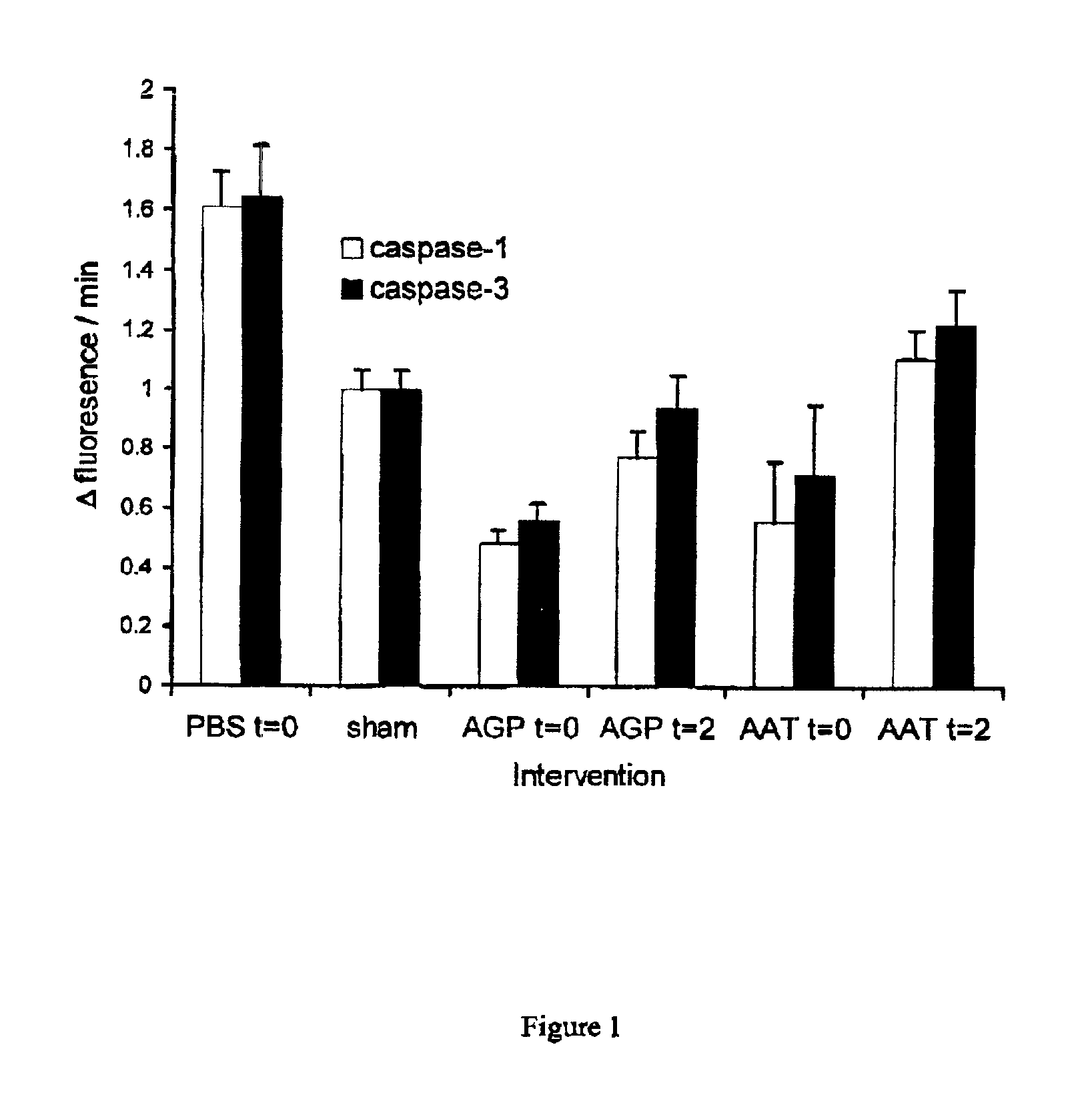Methods and active substances for protecting organs
a technology for protecting organs and active substances, applied in the field of protecting organs, tissues and organ functions, can solve the problems of transplanted organ dysfunction, patient death, cold ischemia in organ transplantation, etc., and achieve the effect of preventing reperfusion-induced organ dysfunction
- Summary
- Abstract
- Description
- Claims
- Application Information
AI Technical Summary
Benefits of technology
Problems solved by technology
Method used
Image
Examples
example 1
AGP and AAT Reduce Early and Delayed Reperfusion-Induced Apoptosis After Ischemia
[0058]To induce renal I / R, mice weighing 20-25 g were subjected to 45 minutes of unilateral ischemia of the left kidney by clamping the renal vessels as described before (Daemen M. A. et al., Circulation 102:1420-1426, 2000). Contralateral nephrectomy was performed and the clamp removed, At reperfusion, 12 mice were administered intraperitoneally 5 mg bovine or human AGP or 0.5 mg human AAT in 0.5 ml sterile PBS, which resulted in serum concentrations similar to those observed during acute phase reaction. 8 mice received AGP or AAT 2 hours after reperfusion. 10 control mice received 0.5 ml PBS and 12 sham-operated mice were subjected to same procedure without clamping the renal vessels and treated with PBS. The animals were euthanized at indicated time points and blood samples were collected and the left kidney harvested. The same model of I / R injury was used in all examples.
[0059]Development of reperfu...
example 2
AGP and AAT Reduce Reperfusion-Induced Inflammation After Ischemia
[0062]The effects of AGP and AAT on reperfusion-induced inflammation were studied by assessing renal TNF-α expression and neutrophil influx. AGP and AAT administered at time of reperfusion effectively limited TNF-α expression and neutrophil influx, studied at 24 hours after initiation of reperfusion (FIG. 2). AGP and AAT given after 2 hours of reperfusion attenuated the inflammation at 24 hours to a lesser extent than did treatment given at time of reperfusion (FIG. 2). However, treatments at both time points decreased inflammation compared with PBS treatment when assessed 24 hours after reperfusion (FIG. 2). The PBS-treated control mice showed significant renal inflammation as reflected by TNF-α expression in the outer stripe of the outer medulla, along the damaged tubular epithelium, and in infiltrating leukocytes. Also, significant renal neutrophil accumulation was reflected by an enhanced myeloperoxidase (MPO) con...
example 3
AGP and AAT Prevent Reperfusion-Induced Renal Dysfunction After Ischemia
[0063]Ischemia-reperfusion of the kidneys resulted in renal dysfunction as reflected by increased blood urea nitrogen (BUN) content and serum creatinine levels 24 hours after reperfusion (FIGS. 3A and B). Compared with PBS, both AGP and AAT administered at time of reperfusion effectively lowered BUN content and serum creatinine levels. However, when administered 2 hours after reperfusion, AGP and AAT failed to significantly decrease BUN or serum creatinine compared with PBS (FIGS. 3A and B). These findings illustrate the importance of the prevention of early apoptotis after reperfusion and the necessity to administer AGP and AAT at the time point of reperfusion in order to achieve optimal therapeutic effect in the prevention of I / R injury. Bovine AGP (FIG. 3), human plasma AGP (FIG. 3) and human AGP lacking the sLex carbohydrate structure had similar efficacy in preventing reperfusion-induced renal dysfunction a...
PUM
| Property | Measurement | Unit |
|---|---|---|
| Concentration | aaaaa | aaaaa |
| Density | aaaaa | aaaaa |
| Frequency | aaaaa | aaaaa |
Abstract
Description
Claims
Application Information
 Login to View More
Login to View More - R&D
- Intellectual Property
- Life Sciences
- Materials
- Tech Scout
- Unparalleled Data Quality
- Higher Quality Content
- 60% Fewer Hallucinations
Browse by: Latest US Patents, China's latest patents, Technical Efficacy Thesaurus, Application Domain, Technology Topic, Popular Technical Reports.
© 2025 PatSnap. All rights reserved.Legal|Privacy policy|Modern Slavery Act Transparency Statement|Sitemap|About US| Contact US: help@patsnap.com



